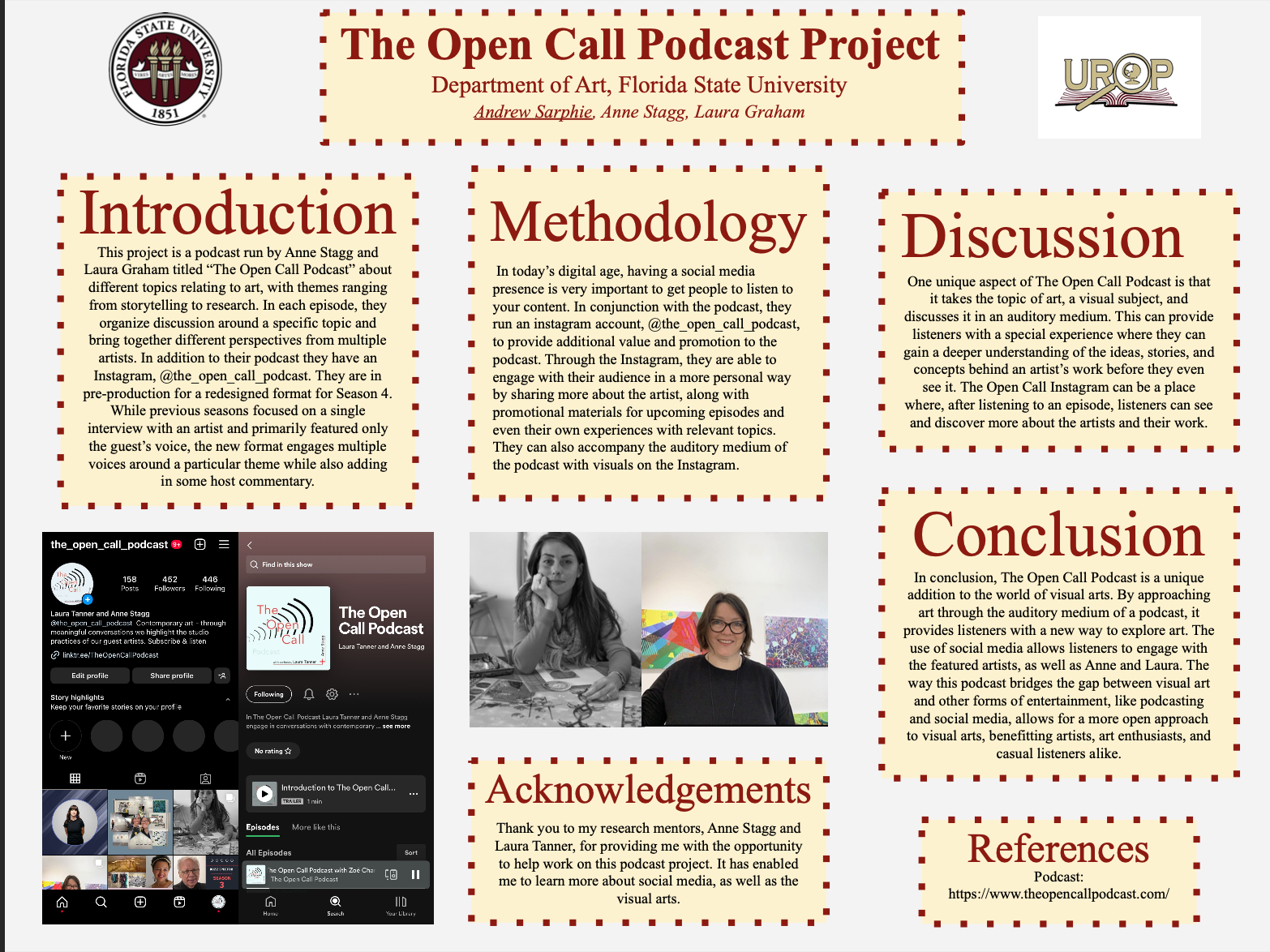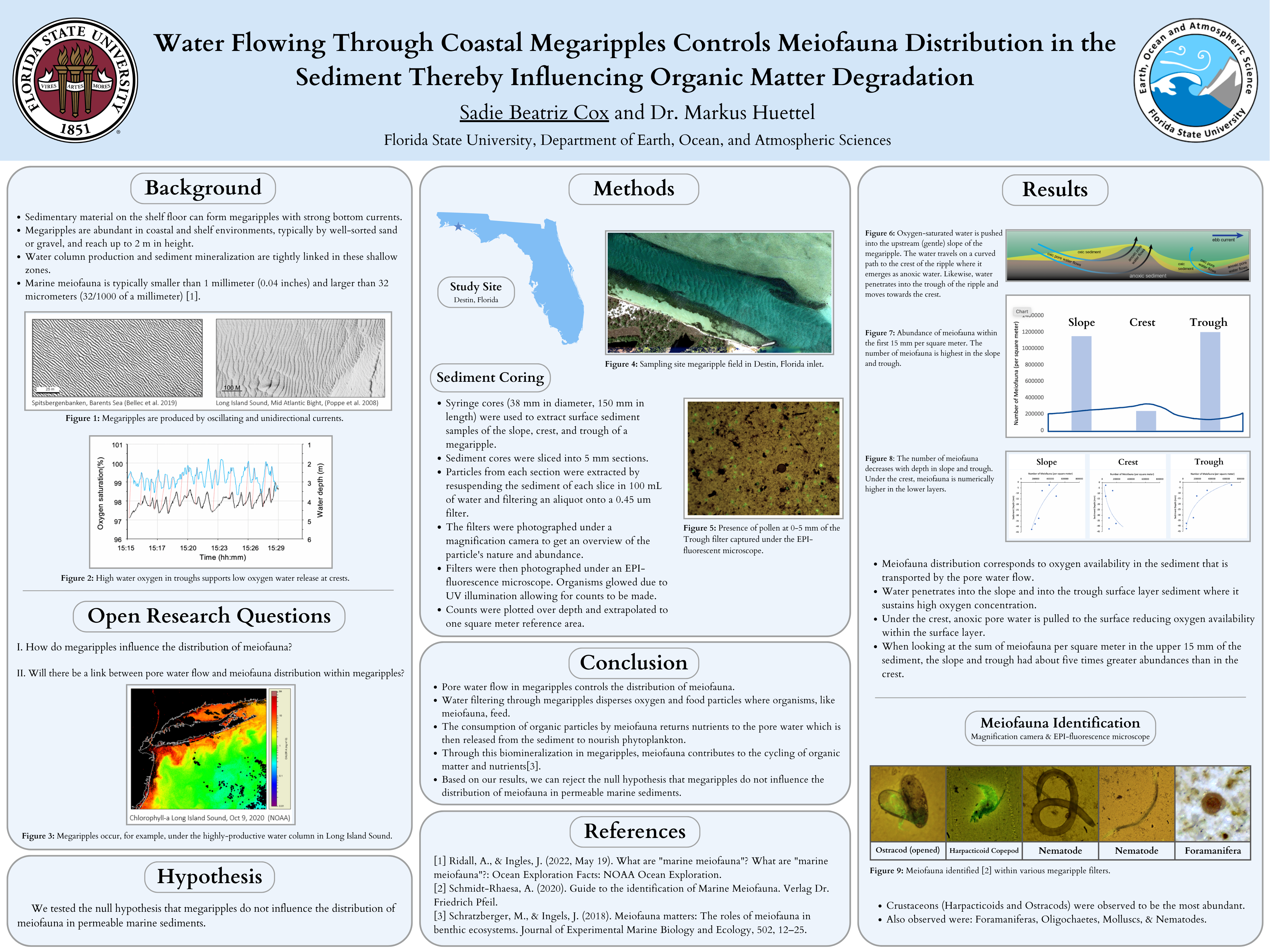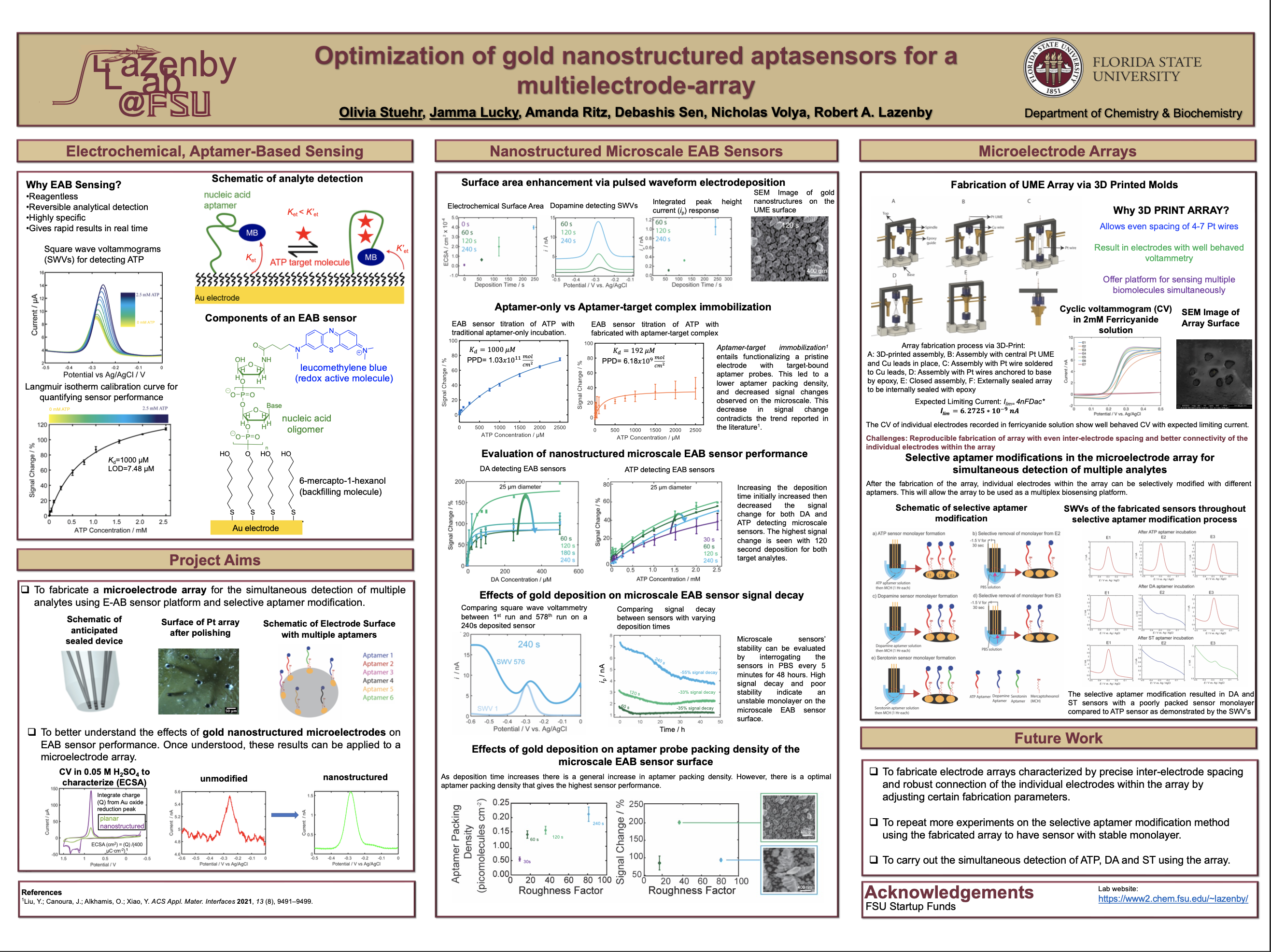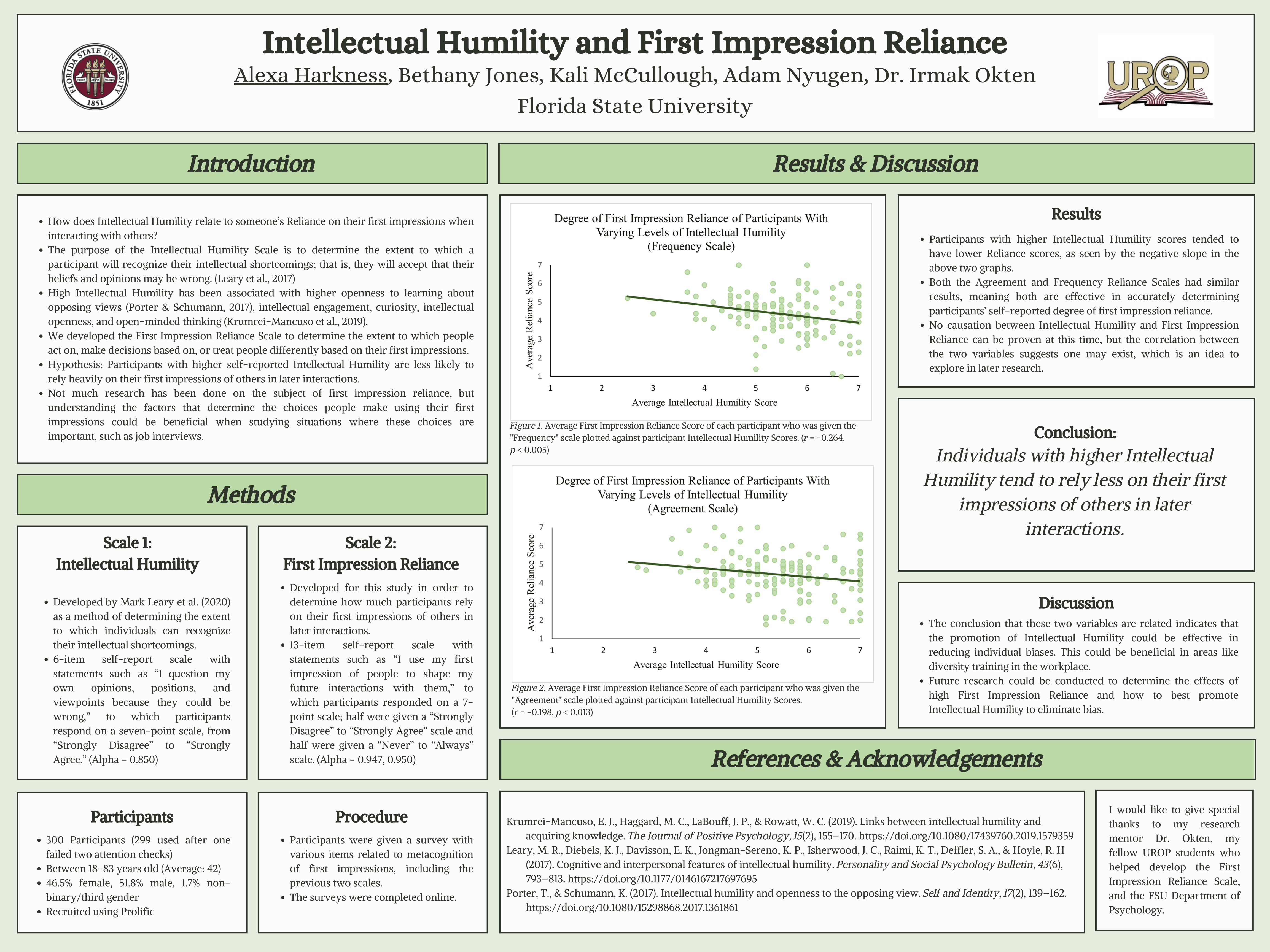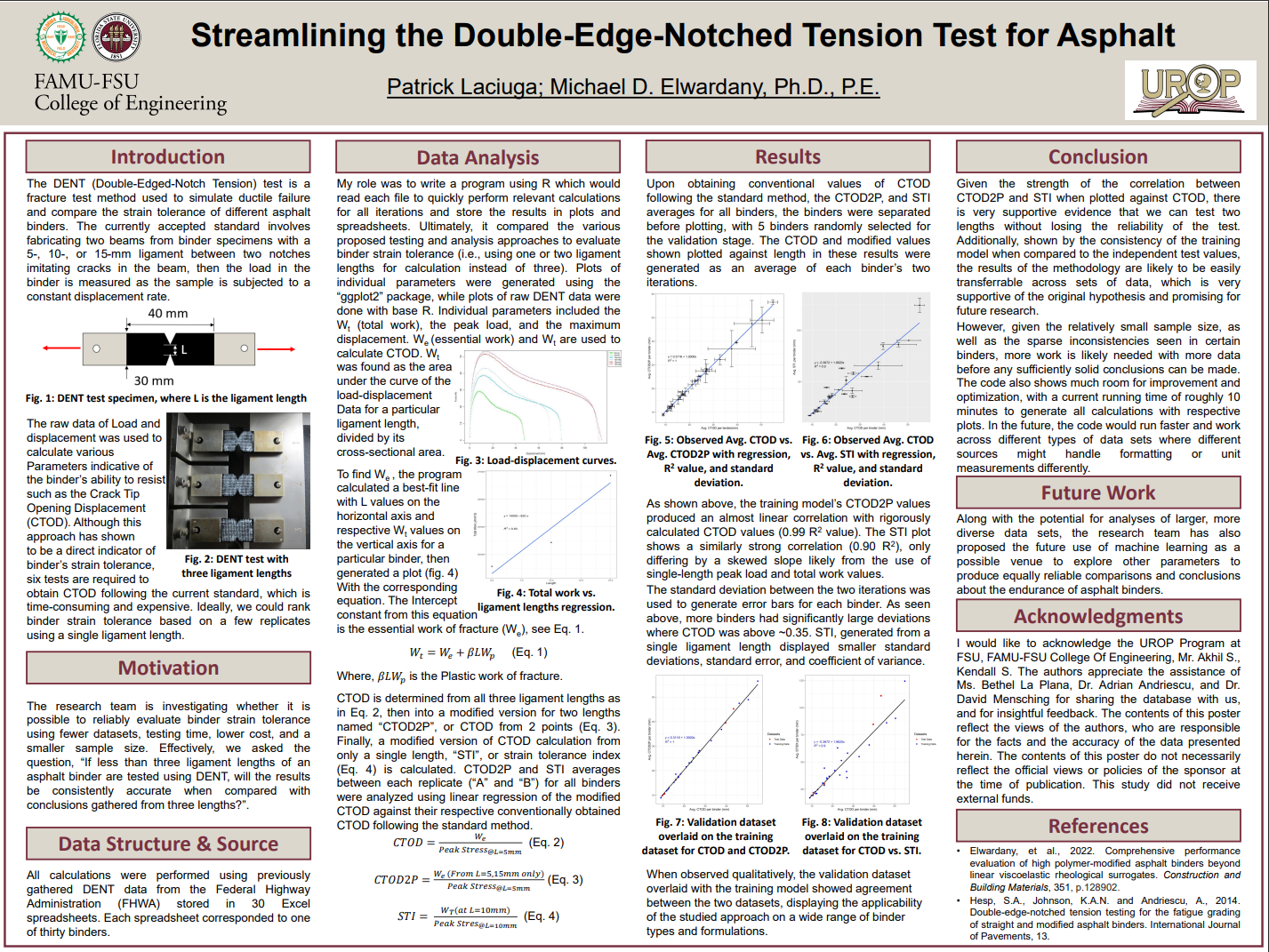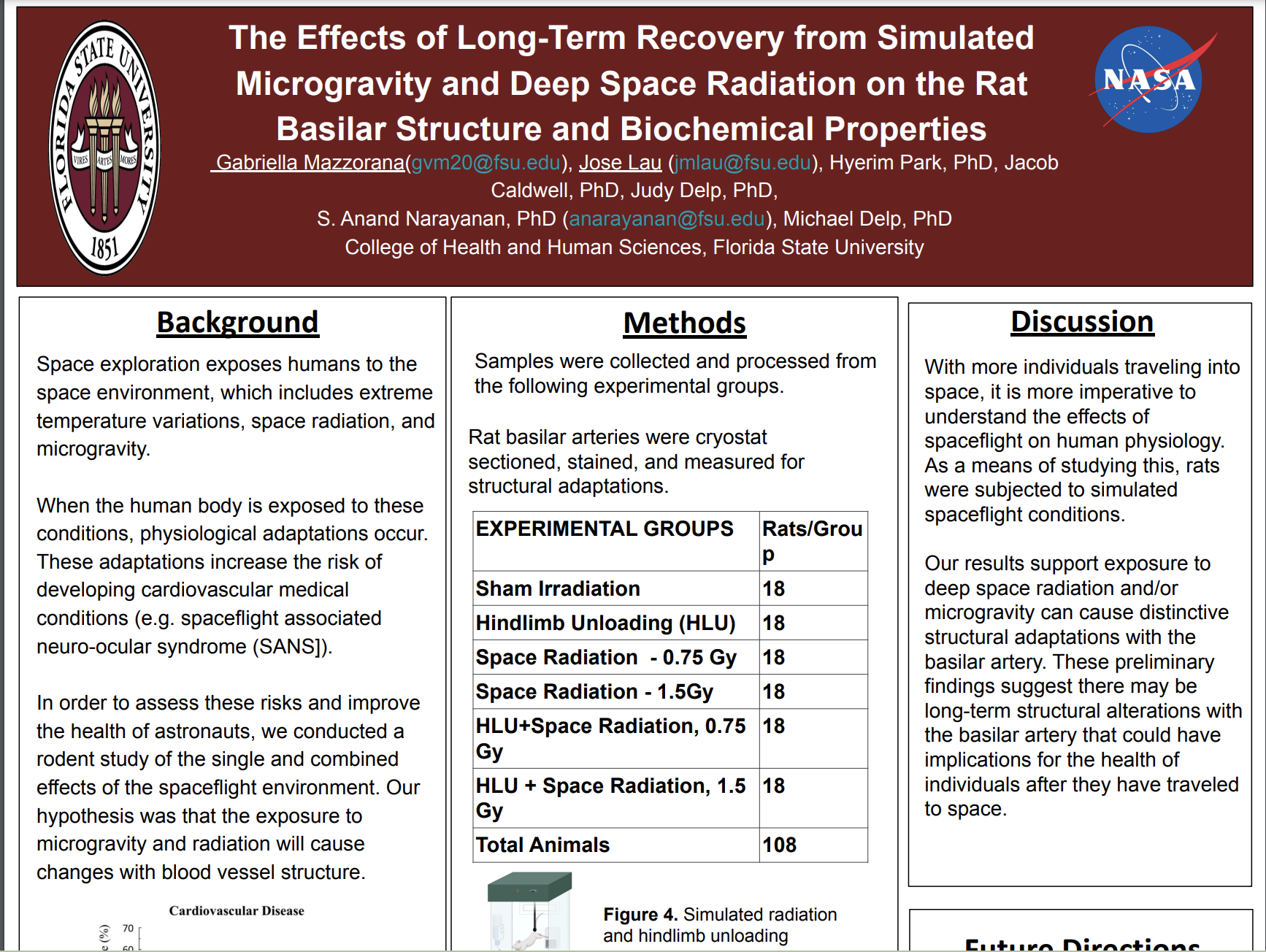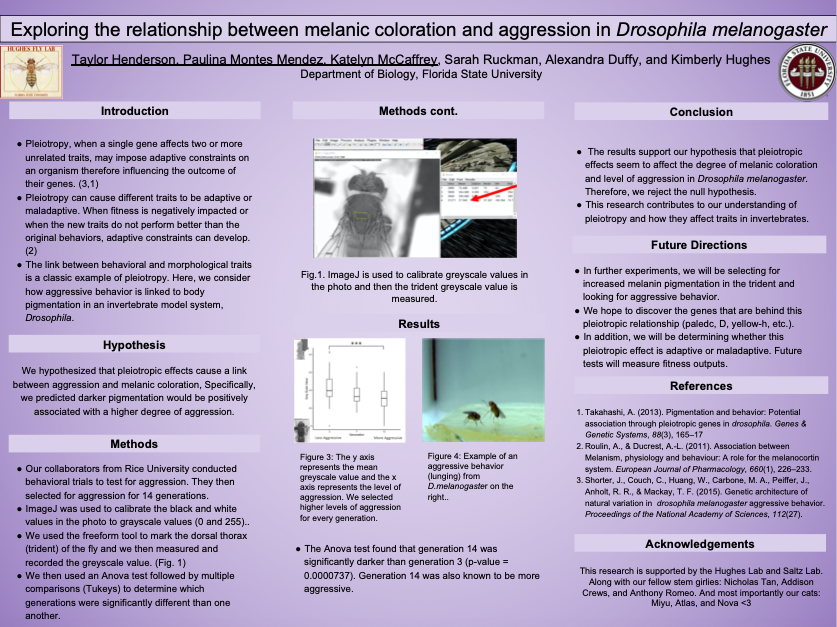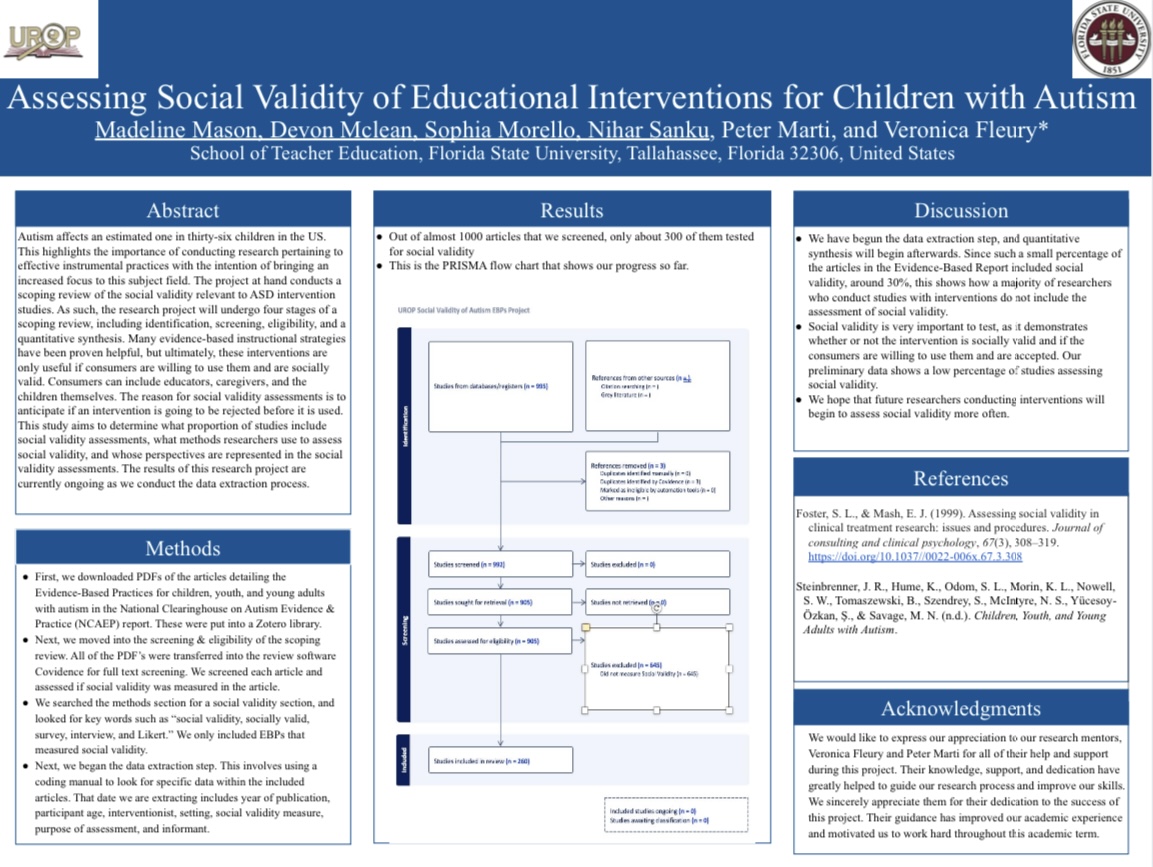Research Symposium
23rd annual Undergraduate Research Symposium, April 6, 2023
Gabriella Mola Poster Session 4: 4:00 pm - 5:00 pm/ Poster #197
BIO
I am a sophomore at Florida State University pursuing a dual degree in English Literature and Philosophy. I'm from Orlando, Florida. I'm on a pre-law track and hope to go to law school after graduating from FSU.
Dante Today: Dante's Influence on Modern & Contemporary Poetry
Authors: Gabriella Mola, Dr. Elizabeth CoggeshallStudent Major: English and Philosophy
Mentor: Dr. Elizabeth Coggeshall
Mentor's Department: Modern Language and Linguistics Mentor's College: Italian Co-Presenters:
Abstract
The Divine Comedy chronicles a journey led by Virgil through 3 parts, Hell, Purgatory, and Paradise, also known as Inferno, Purgatorio, and Paradiso. Since it was first penned between 1307 and 1321, Dante Alighieri’s Divine Comedy has influenced culture and literature. Poetry is not an exception to this. Modern and contemporary poetry is incredibly influenced by Dante’s Divine Comedy. This present study archives references to Dante and his Divine Comedy through the use of the website Dante Today. The site has been online since 2006 and has two goals: to provide a centralized database for references to Dante and to provide data for scholars interested in how Dante’s impact is still alive in contemporary culture. By using this digital database, it is clear how impactful Dante’s Divine Comedy is within the poetry field.
Keywords: Dante, Poetry, Divine Comedy
23rd annual Undergraduate Research Symposium, April 6, 2023
Andrew Sarphie Poster Session 2: 1:30 pm - 2:30 pm/ Poster #23
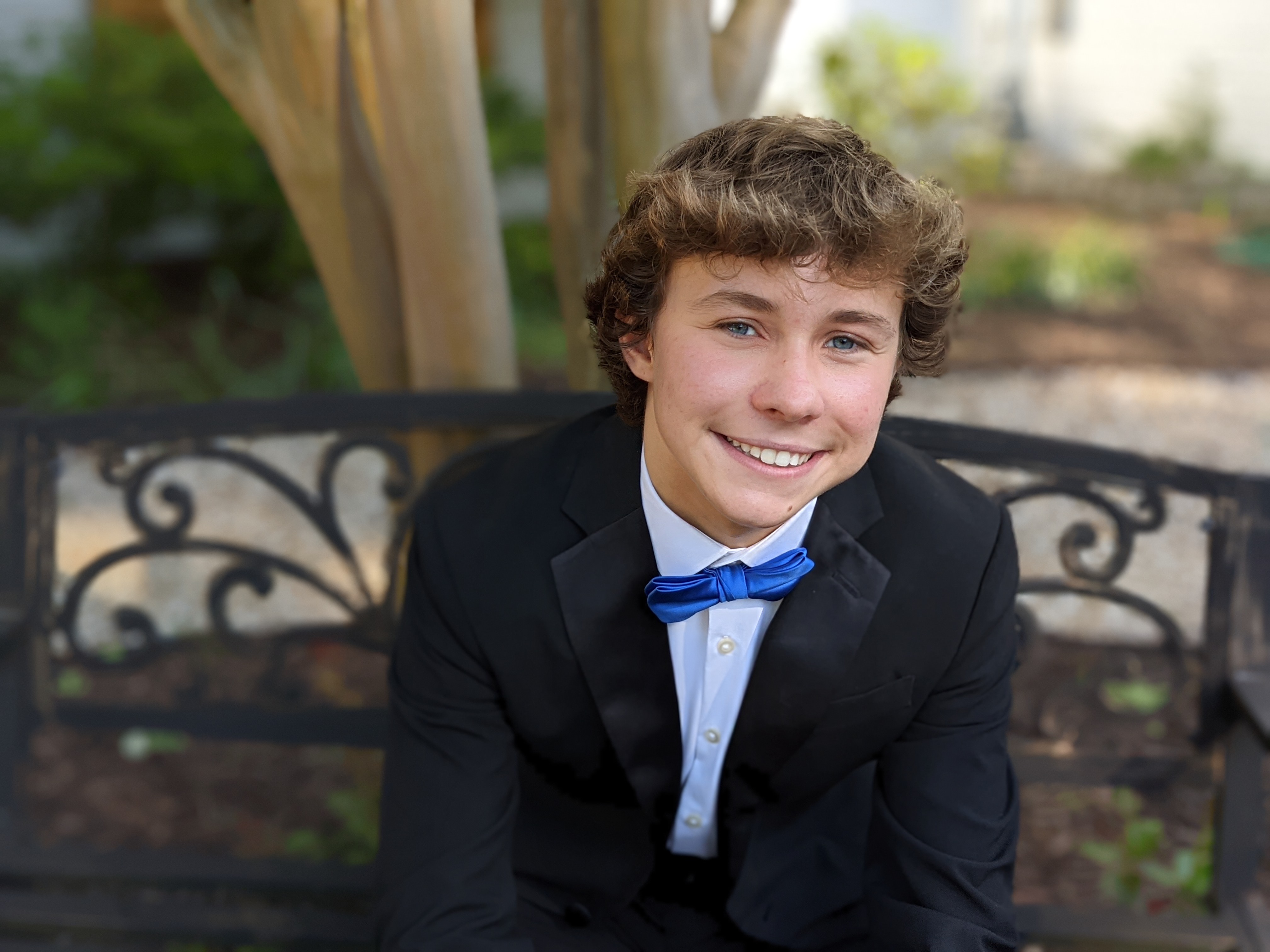
BIO
Andrew Sarphie is an accounting major at Florida State University. He is passionate about social media and in this research project, he is responsible for running the social media for the Open Call Podcast. He also enjoys posting ASMR videos on his YouTube channel, Sarphdog ASMR.
The Open Call Podcast Project
Authors: Andrew Sarphie, Anne StaggStudent Major: Accounting
Mentor: Anne Stagg
Mentor's Department: Art Mentor's College: Art Co-Presenters: N/A
Abstract
This project is a podcast run by Anne Stagg and Laura Graham titled “The Open Call Podcast” about different topics relating to art, with themes ranging from storytelling to research. In each episode, they organize discussion around a specific topic and bring together different perspectives from multiple artists. In addition to their podcast they have an Instagram, @the_open_call_podcast. They are in pre-production for a redesigned format for Season 4. While previous seasons focused on a single interview with an artist and primarily featured only the guest’s voice, the new format engages multiple voices around a particular theme while also adding in some host commentary.
Keywords: podcast, social media, graphic design, marketing, digital media
23rd annual Undergraduate Research Symposium, April 6, 2023
Sadie Beatriz Cox Poster Session 2: 1:30 pm - 2:30 pm/ Poster #416
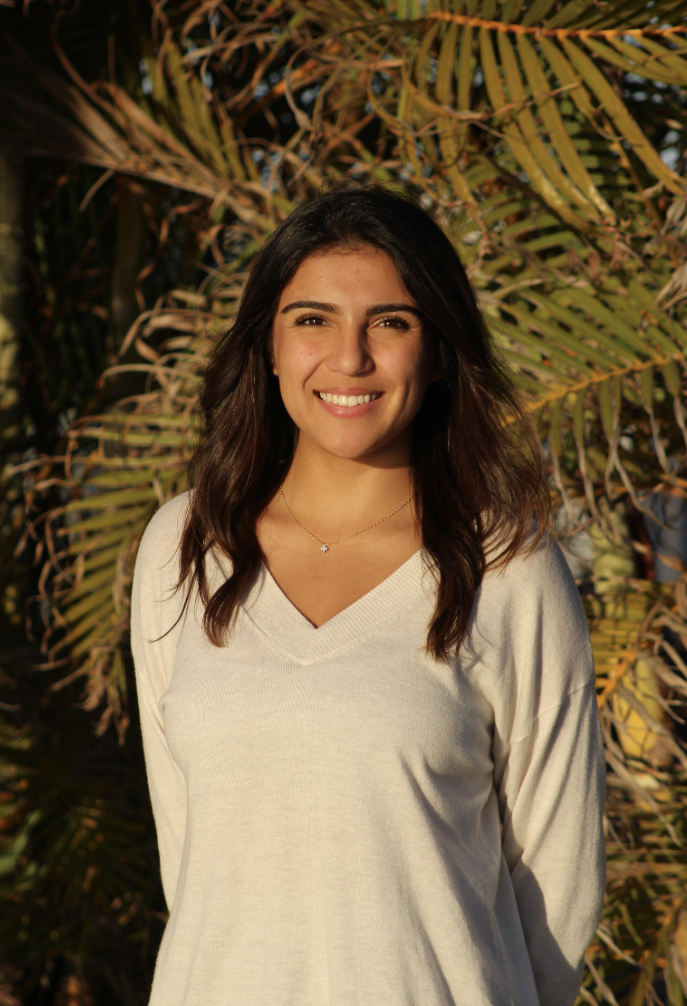
BIO
My name is Sadie Beatriz Cox and I am a senior from Miami, FL. I grew up on both coasts, in Miami, FL & Manhattan Beach, CA, where the ocean revolved around most of my hobbies and interests. I went to high school at MAST Academy in Key Biscayne, FL where I continued to enjoy Marine-based courses. I am PADI Open Water Scuba certified and hope to get Advanced certification before graduating. As my time here comes to an end, I hope to return home to Miami, FL to attend the University of Miami's Rosenstiel School of Marine, Atmospheric, and Earth Science for my Masters in Marine Geoscience and hopefully a Ph.D. In 5 years I hope to see myself continuing researching and still reaching my goal of being a professor.
Water Flowing Through Coastal Megaripples Controls Meiofauna Distribution in the Sediment Thereby Influencing Organic Matter Degradation
Authors: Sadie Beatriz Cox, Dr. Markus HuettelStudent Major: Environmental Science and Policy
Mentor: Dr. Markus Huettel
Mentor's Department: Department of Earth, Ocean, and Atmospheric Sciences Mentor's College: Florida State University Co-Presenters:
Abstract
A large fraction of the organic matter and pollutants released from lands to the oceans is decomposed in continental shelf sediments. About half of the continental shelf consists of covered sandy sedimentary material with sufficient permeability allowing rapid aerobic degradation of organic matter and nutrient remobilization. The sedimentary material on the shelf floor can form megaripples if bottom currents are strong, as can be seen in the inlet to Choctawhatchee Bay at Destin, FL. The goal of this study was to determine if megaripples act as large sand filters and influence sedimentary meiofauna. We tested the working hypothesis that slope, crest, and trough sediments of the megaripples differ in their particle content and meiofauna abundance. Sediment cores extracted vertically from the slope, crest, and trough of the megaripple highlighted the relationship between pore water flow direction and particle concentration in the sediment. Slope and trough were found to effectively filter water, revealing higher particle matter concentrations towards the sediment surface whereas the crest filtered less as revealed by a lower concentration of particulate matter in the sand. The benthic meiofauna (mostly small crustaceans, nematodes, and oligochaetes) followed this distribution. The study determined that the distribution patterns of organisms in the core followed the density of distributed matter. Megaripples thus act as large filter systems controlling organic matter distribution in the sediment surface layers and thereby also strongly influence the distribution of the benthic meiofauna.
Keywords: marine, meiofauna, megaripple, distribution, degradation
23rd annual Undergraduate Research Symposium, April 6, 2023
Gabriela De Jesus Poster Session 3: 2:45 pm - 3:45 pm/ Poster #252
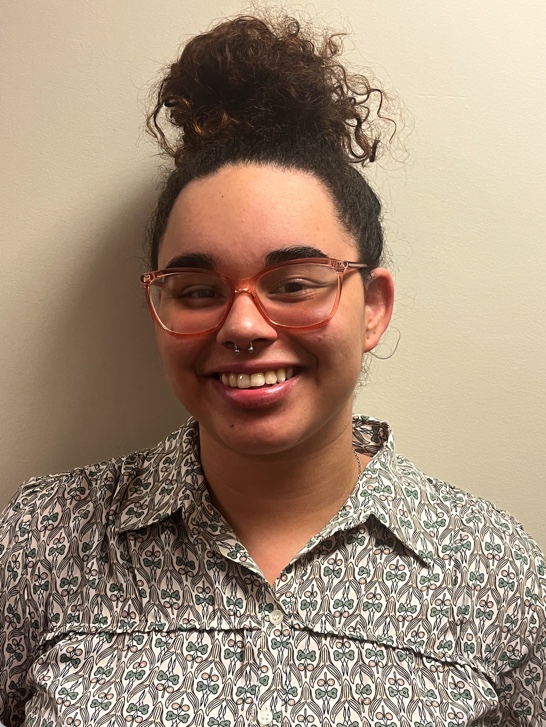
BIO
Hello, my name is Gabriela De Jesus and I am currently a Sophmore at Florida State majoring in Environmental Science. I worked alongside Michael Core and Dr. Minna Jia to study what factors will affect the evacuation rates of people in different counties along the Florida panhandle.
REACTIONS TO DUAL DISASTERS IN THE FLORIDA PANHANDLE
Authors: Gabriela De Jesus, Michael CoreStudent Major: Environmental Science
Mentor: Michael Core
Mentor's Department: Florida Resource and Environmental Analysis Mentor's College: Institute of Science and Public Affairs Co-Presenters: Flora Domitrovic
Abstract
Florida counties have different ways of dealing with natural disasters and public health emergencies, weather they enforce evacuation, provide shelters, or provide resources. The way people choose to react to disasters depends a lot on their circumstances and what their county provides for them. This research aims to look at Census data taken in 2020 and look at the correlation between how people act during a natural disaster and their living circumstances.
Keywords: Dual Disasters, evacuation, hurricane
23rd annual Undergraduate Research Symposium, April 6, 2023
Jamma Lucky Poster Session 2: 1:30 pm - 2:30 pm/ Poster #276
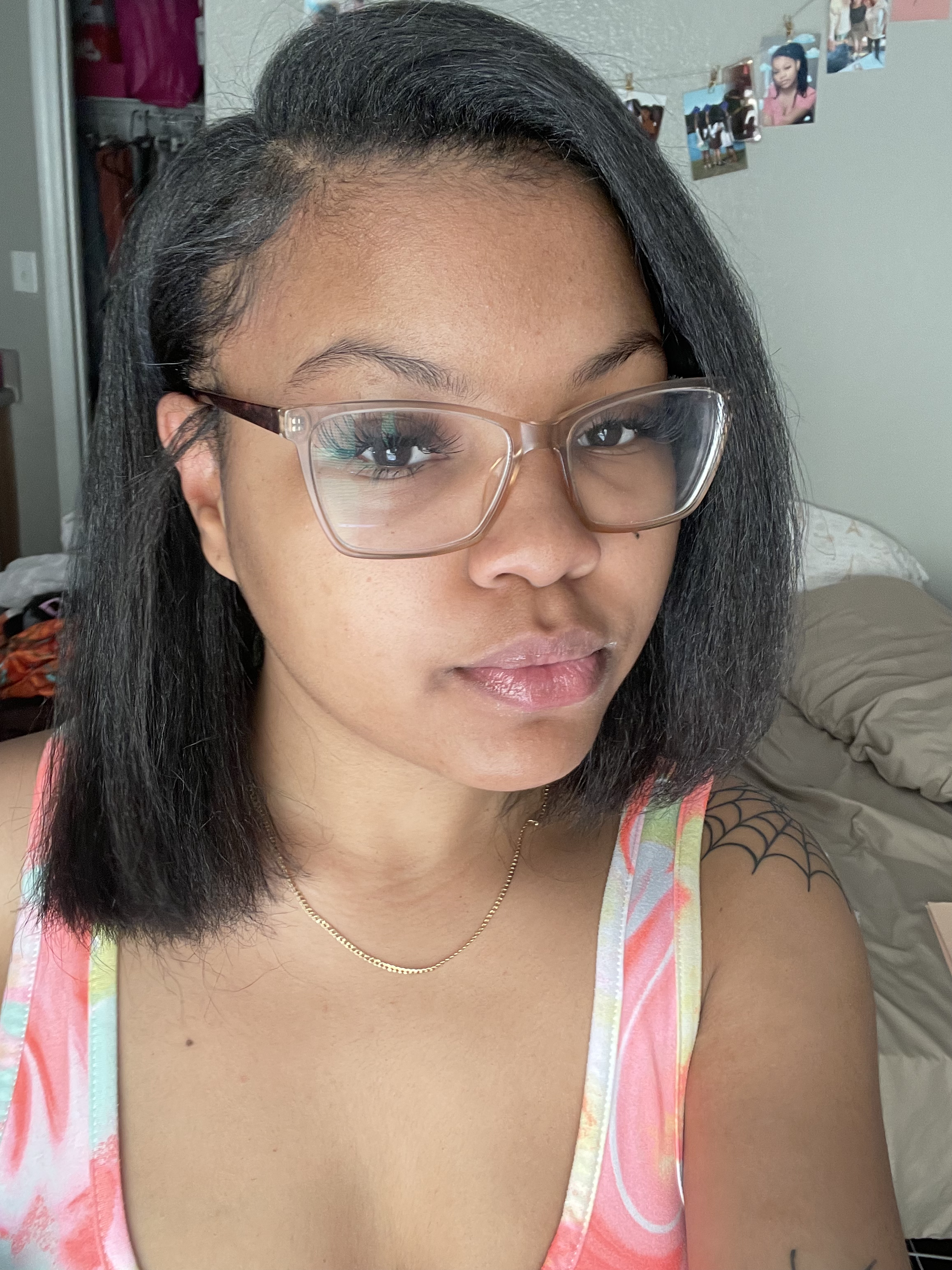
BIO
I am a fourth-year senior from Atlanta, Georgia with a burning passion for chemistry and knowledge. I am a proud brother of Alpha Chi Sigma, a professional chemistry fraternity as well as a student researcher for Dr. Robert Lazenby focusing on Electrochemistry. I will be graduating in August 2023 upon which I plan to pursue higher education and a career in chemical research.
Optimization of gold nanostructured aptasensors for a multielectrode-array
Authors: Jamma Lucky, Robert LazenbyStudent Major: Biochemistry
Mentor: Robert Lazenby
Mentor's Department: Chemistry Mentor's College: Florida State University Co-Presenters: Olivia Stuehr
Abstract
Electrochemical, aptamer-based (EAB) sensors are an emerging class of biosensors with promising applications for point-of-care (POC) devices and have been used to detect and quantify a wide range of biological and chemical analytes with high specificity. EAB sensors can be fabricated on numerous electrode surfaces such as gold. There are various methods of increasing the microscopic surface area and this is typically done to accommodate a greater number of aptamer probes on the surface to enhance the current response, which is particularly important for miniaturized sensors made from a 25-µm diameter wire. Previous attempts to increase the surface area have not thoroughly assessed the effects of gold morphology on the performance of EAB sensors on miniaturized sensors. Here, we used different electrodeposition conditions to deposit gold nanostructures on the microelectrode surface to increase the microscopic surface area, control surface morphology, and explore the resulting effects on EAB sensor performance. In order to evaluate performance, we fabricated sensors using aptamers specific to target analytes adenosine triphosphate (ATP) and dopamine (DA), then interrogated them using square wave voltammetry, and cyclic voltammetry. We can then apply these conditions and results to optimize sensing performance on a microelectrode array. The arrays are created using a custom-made 3D printed device which allows for the fabrication of closely placed microelectrodes. This creates a platform for microscale aptasensors which can be used for the simultaneous detection of multiple analytes.
Keywords: Electrochemistry, Array, Biosensor
23rd annual Undergraduate Research Symposium, April 6, 2023
Emily Fitzgerald Poster Session 2: 1:30 pm - 2:30 pm/ Poster #210
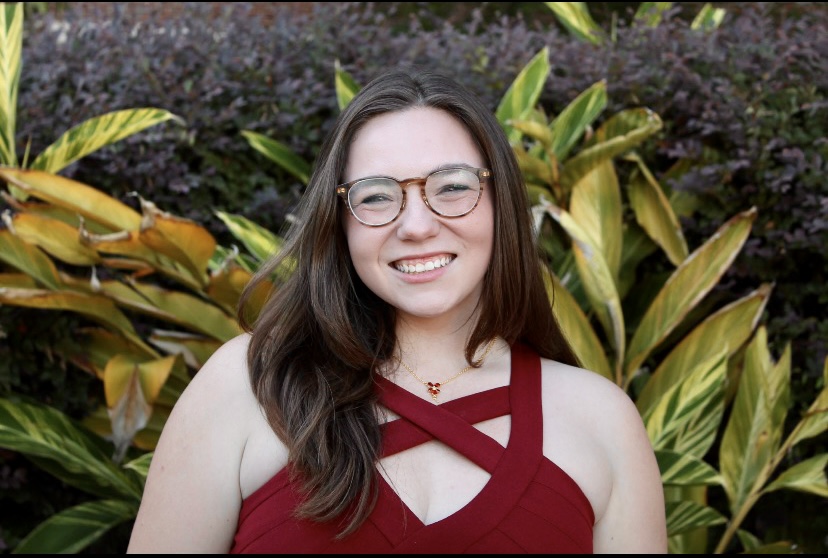
BIO
I am pursuing a major in Behavioral neuroscience with a certificate in developmental
disabilities. My inspiration to go into this field comes from my little brother who was diagnosed
with Autism at the age of two. As he grew up, I worked closely with him on basic things such as
reading and writing, but also more complex things like such as
understanding others’ emotions and eating mixed foods. While teaching my brother these everyday
tasks I realized I had a passion for helping children with developmental disabilities. This fueled
my interest in behavioral neuroscience as I continued to work with children who have disorders
such as Jordan's Syndrome, Autism, ADHD, Anxiety, Depression, Disruptive Mood
Dysregulation Disorder, and Down Syndrome.Although understanding how
people present their behavior is fascinating, I am equally interested in how the behavior is
expressed in the brain. I would like to become a Child Psychiatrist while working specifically with individuals who have Neurodevelopmental disabilities.
Fostering Intercultural Interactions and Outcomes for Graduate Students Through Internationalization-at-Home Efforts
Authors: Emily Fitzgerald, ShengLi DongStudent Major: Behavioral Neuroscience
Mentor: ShengLi Dong
Mentor's Department: Department of Educational Psychology and Learning Systems Mentor's College: College of Education Co-Presenters:
Abstract
This study examines the Intercultural interactions between domestic graduate students and international graduate students through the cultural partner program. In higher education within the United States, intercultural efforts are of utmost importance to help with cultural sensitivity and intercultural competency. These efforts help combat common multicultural stigmas and biases that American students may hold. The study comprises of nighty seven participants from the southeastern region of the United States. The experimental group of this study had sixty-eight participants. All these participants were paired with an international graduate-level student to complete multicultural activities throughout the semester. The students in the study had to complete other tasks such as pre-and post-surveys which included psychosocial measures such as well-being, stress, intercultural sensitivity, mindfulness, and perceived support. The statistical analysis found a significant difference in the variable of well-being, however, none of the other variables had a significant difference. Statistical analyses of the data found that there were improved reports of stress, perceived support, and interaction attentiveness throughout the semester.
Keywords: Intercultural, Diversity, Internationalization-at-home
23rd annual Undergraduate Research Symposium, April 6, 2023
Rachel Walsh Poster Session 1: 11:00 am - 12:00 pm/ Poster #299
BIO
I am a sophomore Biochemistry and Environmental Science major at FSU. I am interested in a career studying Astrobiology, the study of life in the universe.
Unveiling the Mysteries of Chemical Gardens: Bubble Formation and Gas Composition
Authors: Rachel Walsh, Oliver SteinbockStudent Major: Biochemistry, Environmental Science
Mentor: Oliver Steinbock
Mentor's Department: Department of Chemistry and Biochemistry Mentor's College: College of Arts and Sciences Co-Presenters:
Abstract
Chemical gardens are precipitate structures formed when a metal salt seed is placed into a sodium silicate solution. Often, the tube is guided by a bubble Our studies focus on analyzing the gas bubble’s composition through spectroscopy and optical analysis. The natural formation of chemical gardens can be seen in the deep ocean, an environment with ample dissolved CO2. The addition of the metal salt seed acidifies the basic sodium silicate solution, lowering the solubility of CO2, and forcing the gaseous CO2 out of the solution in the form of bubbles. Combining the silicate solution with a carbonate source can lead to a potential increase in total CO2 released during precipitation.
Keywords: chemistry, chemical gardens, chemobrionics
23rd annual Undergraduate Research Symposium, April 6, 2023
Alexa Harkness Poster Session 1: 11:00 am - 12:00 pm/ Poster #22
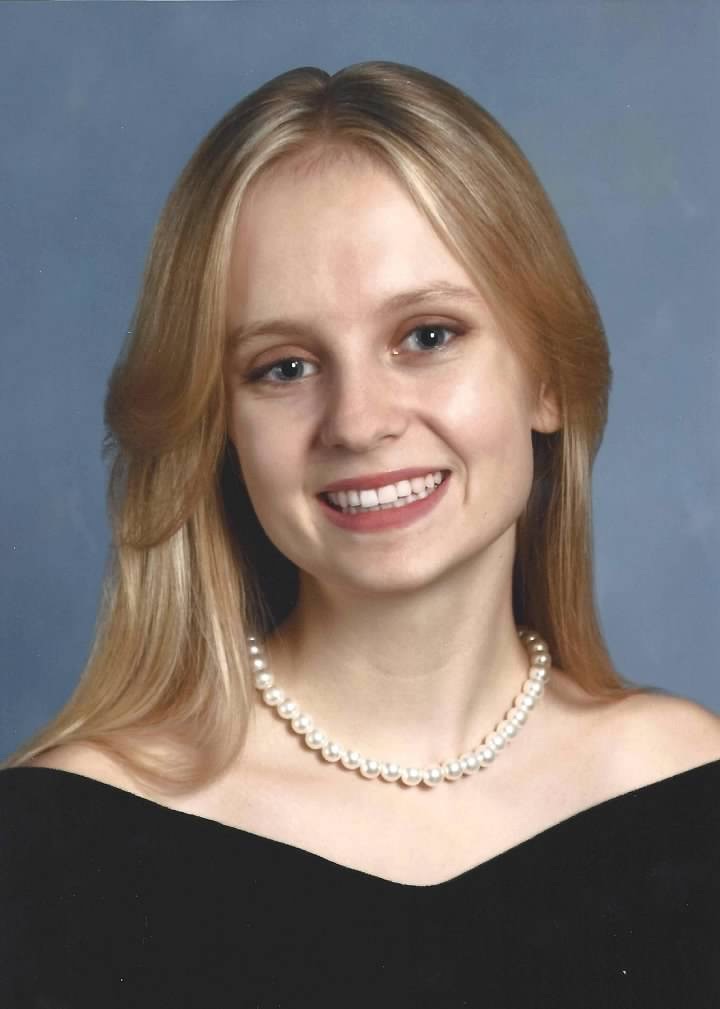
BIO
I am a first year Honors student studying Biological Sciences. I am currently working on research regarding first impressions and bias regulaation.
Intellectual Humility and First Impression Reliance
Authors: Alexa Harkness, Dr. Irmak Olcaysoy OktenStudent Major: Biological Science
Mentor: Dr. Irmak Olcaysoy Okten
Mentor's Department: Psychology Mentor's College: Psychology Co-Presenters:
Abstract
Intellectual Humility is a character virtue referring to an individual’s ability to recognize their intellectual shortcomings and become open to new perspectives. We wanted to determine how this character virtue relates to individuals’ self-reported tendency to use their first impressions when making decisions of another individual. Doing so can be problematic, as people who rely heavily on first impressions may not consider the idea of them being wrong. We hypothesized that participants with higher levels of Intellectual Humility would be less likely to rely heavily on their first impressions of others in later interactions. We surveyed 300 participants using an online survey with a preexisting self-reported Intellectual Humility Scale and a self-reported First Impression Reliance Scale that we developed. As predicted, our results demonstrated a negative association between the two variables; participants with higher Intellectual Humility tended to have lower First Impression Reliance. This study contributed to the literature on impression formation by introducing and validating a new measure of First Impression Reliance. Further, it contributed to the limited amount of work examining Intellectual Humility within the context of person perception. Further research should validate the First Impression Reliance Scale in different contexts and replicate these findings. The findings from this study suggest that the promotion of Intellectual Humility could be effective in reducing individual biases and encouraging a more analytical perspective when forming impressions of others. This could be beneficial in areas like diversity training in the workplace.
Keywords: Psychology, Impressions, Intellectual Humility
23rd annual Undergraduate Research Symposium, April 6, 2023
Santiago Lazarte Poster Session 1: 11:00 am - 12:00 pm/ Poster #410
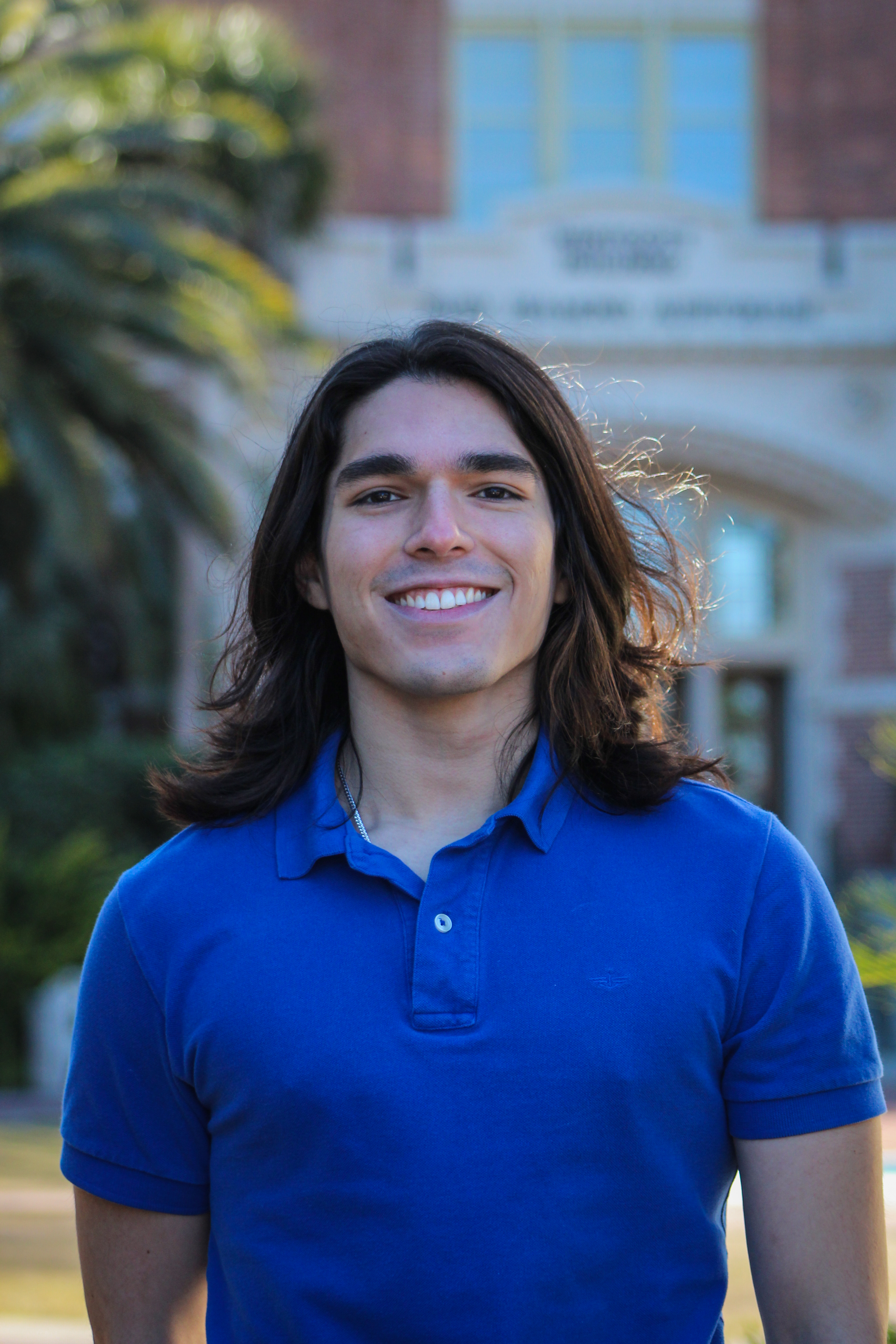
BIO
Santiago Lazarte is a junior in Biomedical Engineering. He currently works as an undergraduate research assistant in the Surface Interfaces and Materials Tribology Laboratory under Dr. Brandon Krick. He intends to pursue a Ph.D. in Materials Sciences in the future. During his free time, he likes to read, play chess, and spend time with friends.
Characterization of Mechanical Properties of Solvent-Cast 3D-Printed Peptide-polymer Scaffolds for Osteochondral Tissue Regeneration
Authors: Santiago Lazarte, Brandon KrickStudent Major: Biomedical Engineering
Mentor: Brandon Krick
Mentor's Department: Mechanical Engineering Mentor's College: FAMU-FSU College of Engineering Co-Presenters:
Abstract
Interactions between cells and biomaterials are essential to regenerating functional tissue. Cells are affected by chemical, mechanical, and other biological cues from their microenvironment. These cues can be functionally embedded in 3d-printed scaffolds for directing mesenchymal stromal cell (MSC) differentiation to spatially direct tissue regeneration. In many tissue regeneration applications, including the osteochondral (bone-cartilage) system, the mechanical properties of the scaffold must be tuned to perform a physiological function (i.e. support load) while the new tissue is generated. This work explores how differences in the architectures of solvent-cast 3D printed peptide-polymer scaffolds as well as polymer conjugate concentration will affect their mechanical properties. In this work, we explore different metrics for characterizing the mechanical properties of the scaffolds, mainly through microindentation.
Keywords: Tribology, Engineering, Regeneration, 3D Printing, Scaffolds
23rd annual Undergraduate Research Symposium, April 6, 2023
Patrick Laciuga Poster Session 3: 2:45 pm - 3:45 pm/ Poster #306
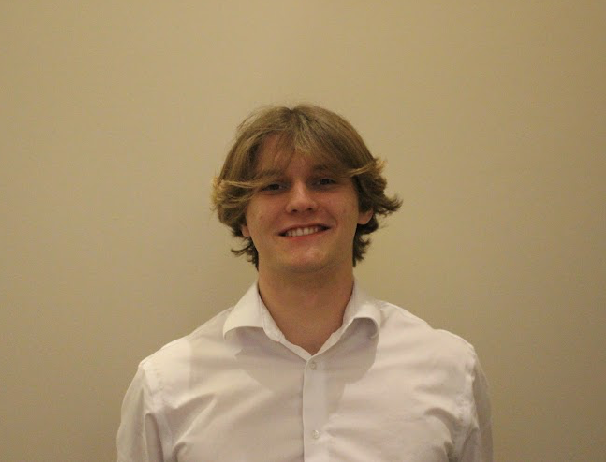
BIO
My name is Patrick Laciuga and I am a first-year computer engineering student at FSU. I took this academic path because of my long-time interests in computer hardware, but I also enjoy math/problem-solving and thus am also very interested in data analysis or coding whenever applicable.
Streamlining the Double-Edge-Notched Tension Test for Asphalt
Authors: Patrick Laciuga, Dr. Michael ElwardanyStudent Major: Computer Engineering
Mentor: Dr. Michael Elwardany
Mentor's Department: Civil Engineering Mentor's College: FAMU-FSU College of Engineering Co-Presenters:
Abstract
The Double-Edged Notch Tension (DENT) test is a fracture mechanics test method which compares asphalt binders’ cracking resistance by applying a constant displacement rate on double-edged-notched beams and measuring tension forces. Typically, DENT data is gathered from six beams, in which two replicates are tested at three ligament lengths: 5, 10, and 15 mm. This data is used to calculate the binder’s Crack Tip Opening Displacement (CTOD), which indicates binder’s strain tolerance and resistance to cracking at intermediate temperatures (i.e., 15-25˚C). However, conducting the test using two replicates and three ligament lengths requires extensive preparation and testing time, large sample sizes (~150 grams), and consequently high cost. The goal of this research is to find out whether it is possible to gather an equally reliable alternative to CTOD, reaching the same general conclusions, using data gathered from less than three ligament lengths. This was done using previously gathered DENT data from tests conducted using 5-, 10-, and 15-mm ligament lengths of 30 different binders. The data was analyzed en-masse using code written in the R programming language, to generate a model for predicting measurements of all lengths using linear regression analyses, comparing rigorously calculated CTOD values to values generated from two ligament lengths, and values from one. Results so far have showed an almost linear correlation (0.99 R-squared) in the training data of the model for CTOD calculated from two ligament lengths, and 0.9 R-squared between CTOD and a single-length substitute for CTOD called STI (strain tolerance index)
Keywords: Civil Engineering, Asphalt, Data
23rd annual Undergraduate Research Symposium, April 6, 2023
Marc Jacobs Poster Session 4: 4:00 pm - 5:00 pm/ Poster #303
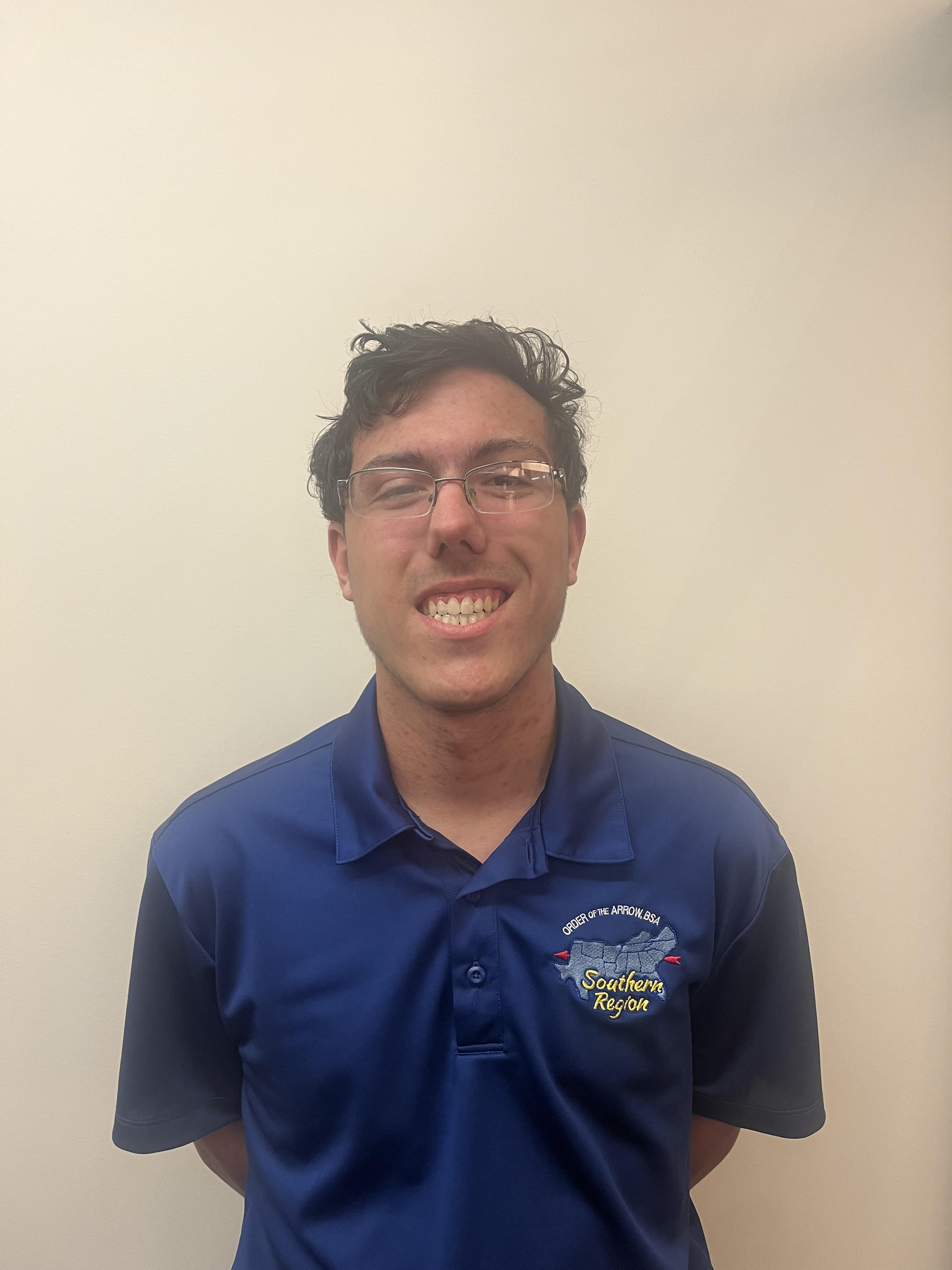
BIO
Hi everyone! My name is Marc Jacobs from Maitland Fl, and I am currently studying mechanical engineering at Florida State University. In my free time, I enjoy hiking, kayaking, and playing tennis.
An Intervention Program On Assisting Transition For The First-Year College Students With Disabilities
Authors: Marc Jacobs, Dr. Shengli DongStudent Major: Pre-Mechanical Engineering
Mentor: Dr. Shengli Dong
Mentor's Department: Department of Educational Psychology and Learning Systems Mentor's College: College of Education Co-Presenters:
Abstract
• The goal of the research is to evaluate the way to empower college students with disabilities to have a successful start to their educational career. The Engage 100 course designed for students with disabilities was evaluated to determine how students felt before and after compared to those who did not take the course. Regarding the participant pool, there were fifty participants all of whom were first year students of a diverse background. In this study, there were thirty-six students in the control group and fourteen in the experimental groups. All students self identified as having disabilities, registered with the OAS office, and gave informed consent to participate. Students that participated in the Engage 100 course were found to score higher in all areas of wellbeing and social success. The results show that the Engage 100 model is successful. Connecting students with disabilities to resources and support early in their educational career was instrumental in their success.
Keywords: Transition for Students with Disabilities
23rd annual Undergraduate Research Symposium, April 6, 2023
Jose Lau Poster Session 2: 1:30 pm - 2:30 pm/ Poster #72

BIO
My name is Jose Lau, and I am a senior at Florida State University studying Exercise Physiology with minors in Biology, Psychology, and Chemistry. I am currently involved in several NASA-funded biomedical research studies under the guidance of my mentor, Dr. Sunny Narayanan. Additionally, I work as a medical assistant at Southern Medical Group, a specialty practice focusing on cardiology and internal medicine.
In my spare time, I volunteer with the Alzheimer's Project, providing comfort, support, and respite care to individuals suffering from memory disorders and their caregivers. I am also an active member of Phi Delta Epsilon, a pre-medical professional fraternity, where I previously served as a social chair.
When I'm not working, volunteering, or conducting research, I enjoy playing basketball with my friends, working out, cooking meals at home, going on runs, taking care of my cat, and being involved in various activities at the most incredible school in the world, Florida State University. As a proud Seminole, I am always excited to represent my school in everything I do, and as always, Go Noles!
The Effects of Long-Term Recovery from Simulated Microgravity and Deep Space Radiation on the Rat Basilar Structure and Biochemical Properties
Authors: Jose Lau, Sunny NarayananStudent Major: Exercise Physiology
Mentor: Sunny Narayanan
Mentor's Department: Biomedical Mentor's College: Florida State University Co-Presenters: Gabriella Mazzorana
Abstract
Human travel into space exposes them to the spaceflight environment, which includes extreme temperature variations, exposure to deep-space radiation, and the effects of weightlessness (e.g. microgravity). Physiological adaptations occur when exposed to these different environmental stimuli; one example includes brain function. Brain function is reliant on adequate blood perfusion supplied by the cardiovascular system. Both the cardiovascular system and the brain have been shown to adapt to extreme conditions such as spaceflight, where astronauts are subjected to environmental factors such as deep-space radiation and microgravity. Some of these changes include cardiovascular adaptations, musculoskeletal deconditioning, and spaceflight-associated neuro-ocular syndrome. To assess these risks and how they may affect the cardiovascular system, we conducted a study of the long-term single and combined effects of deep space radiation and microgravity exposure on rats. Our hypothesis includes studying changes in blood vessel structure and function, as well as biochemical pathway changes (e.g. endothelial nitric oxide synthase [eNOS], oxidative stress) resulting from simulated spaceflight exposure. Biological samples of the rat basilar artery were collected and processed by cryostat sectioning for immunofluorescence protein analysis. The findings from this study will increase our overall knowledge in the field of space medicine and life sciences as well as improve life on Earth through advancements made in medicine and health.
Keywords: NASA, Biomedical, research
23rd annual Undergraduate Research Symposium, April 6, 2023
Osiano Isekenegbe Poster Session 3: 2:45 pm - 3:45 pm/ Poster #302
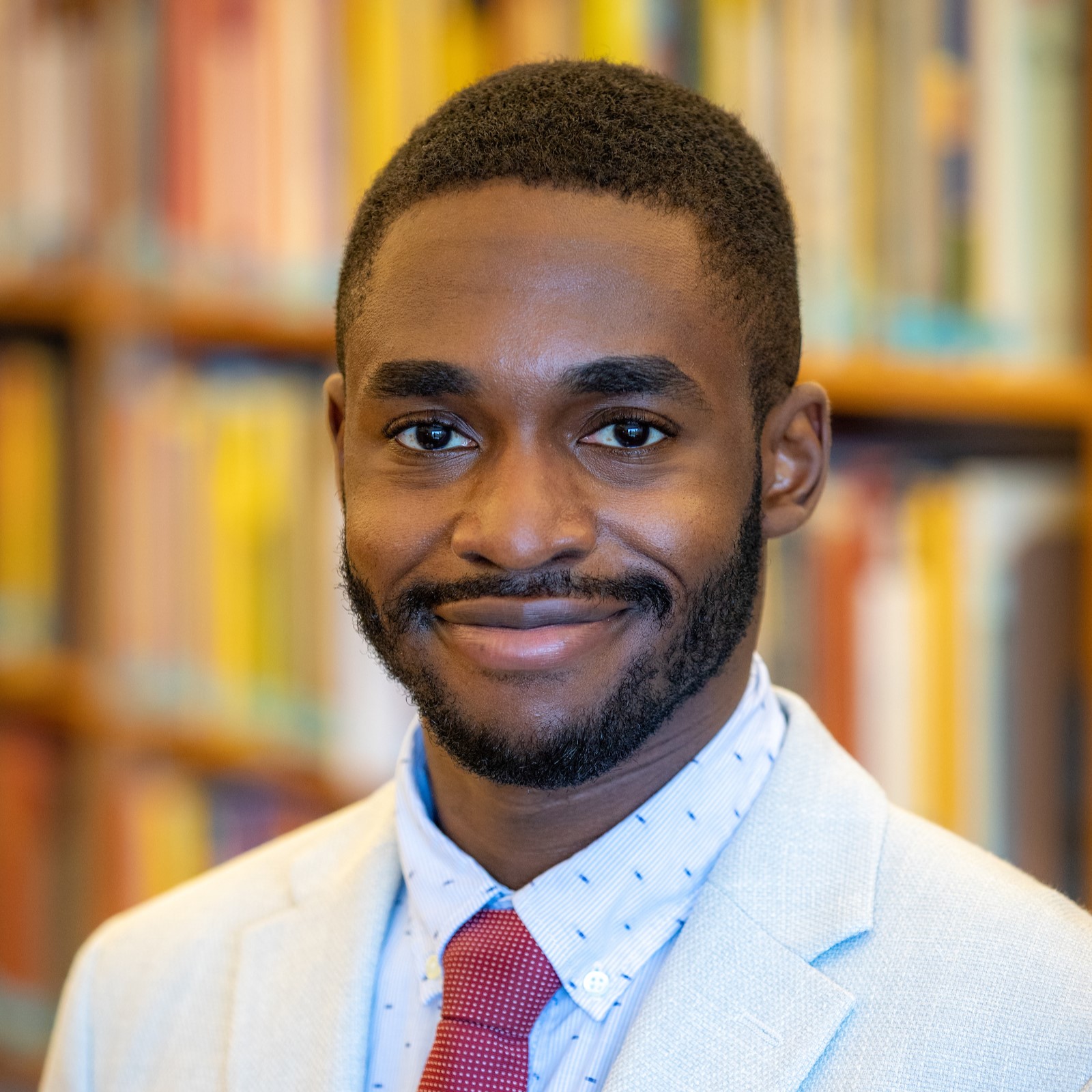
BIO
Osiano Isekenegbe is a senior undergraduate mathematics student. His current research interest concerns algebraic, combinatorial, and geometric approaches to mathematical neuroscience. Outside of mathematics, he enjoys learning French, playing pool, and reading science fiction and fantasy novels. He will pursue Ph.D. studies in mathematics and looks forward to a career as a researcher and educator.
Convexity of Four-Maximal Neural Codes
Authors: Osiano Isekenegbe, Dr. Federico ArdilaStudent Major: Mathematics
Mentor: Dr. Federico Ardila
Mentor's Department: Department of Mathematics Mentor's College: San Francisco State University Co-Presenters:
Abstract
A central challenge facing neuroscientists is deciphering neural code and understanding the relationship between stimuli and neural activity. A motivating example comes from hippocampal place cells observed in rats, humans, and other animals, which fire when the animal is in specific regions (place fields) of its environment. This firing helps the brain determine the animal's position. Interestingly, place fields are experimentally observed to be almost convex. To mathematically represent the stimuli-neural activity relationship, we use combinatorial neural codes, which record neural activity as a family of sets called codewords. Convex neural codes are those realizable by a family of convex open sets in Euclidean space. As such, convex codes represent a model of place cells and place fields. We desire simple convexity criteria because detecting convexity in arbitrary codes is otherwise NP-hard. Giusti and Itskov identified local obstructions to convexity and Johnston, Shiu, and Spinner showed that these obstructions characterize convexity for codes with at most 3 maximal codewords. Lienkaemper, Shiu, and Woodstock gave an example showing that this is not the case for codes with 4 maximal codewords. In this work, we further examine 4-maximal neural codes. Using combinatorial, geometric, and topological methods, we show that 4-maximal codes corresponding to certain simplicial complexes are convex if and only if they do not have local obstructions. We also give a hypothesis for characterizing the remaining 4-maximal codes and describe interesting results supporting this hypothesis.
Keywords: mathematics, neuroscience, biology, animal, environment
23rd annual Undergraduate Research Symposium, April 6, 2023
Katelyn McCaffrey Poster Session 4: 4:00 pm - 5:00 pm/ Poster #156

BIO
My name is Katelyn McCaffrey. I am majoring in biological sciences here at Florida State University anda am expected to graduate in the Fall of 2023. I am interested in the research field but am not quite sure what kind of research I want to pursue. I hope to find opportunities to explore my interests in different areas of the biological field.
Exploring the relationship between melanic coloration and aggression in Drosophila melanogaster.
Authors: Katelyn McCaffrey, Sarah RuckmanStudent Major: Biological Sciences
Mentor: Sarah Ruckman
Mentor's Department: Biological Sciences Mentor's College: College of Arts and Sciences Co-Presenters: Paulina Montes, Taylor Henderson
Abstract
Adaptive constraints, limitations that influence the outcome of genes, have important connections with the evolution of organisms as well as inheritance of complex traits. Pleiotropic effects are a classic example of an adaptive constraint. Pleiotropy occurs when one gene affects two or more unrelated traits. Here, we looked at melanic coloration and aggressive behavior in Drosophila melanogaster. Melanin production is thought to have an inhibitory effect on the neurotransmitter, dopamine, which can influence aggressiveness. Therefore, we hypothesized that pleiotropic effects cause a correlation between these two traits. Specifically, we predicted darker pigmentation would be positively associated with a higher degree of aggression. To test this, we quantified aggressive behaviors (fencing, boxing, and lunging) and artificially selected for high aggression, low aggression, and no selection (control) for 14 generations. We then measured the pigment of the dorsal thorax (trident) using ImageJ. Thus far, we found that generation 14, which was a more aggressive generation, was significantly darker than generation 3 when using an ANOVA. These results demonstrate a clear relationship between the level of aggression and melanin in D. melanogaster and provides some support for our hypothesis that pleiotropic effects are working on the two traits. However, more research is necessary to substantiate this, tests for the reverse effects, and to discover the genes that are behind this pleiotropic relationship. This research will further our understanding of adaptive constraints and how they affect the evolution of an organism’s traits.
Keywords: D. melanogaster, aggression, melanic coloration
23rd annual Undergraduate Research Symposium, April 6, 2023
Colby Masi Poster Session 2: 1:30 pm - 2:30 pm/ Poster #40

BIO
Hello! My name is Colby Masi, I am a second-year undergrad student. I was born in Sarasota, Florida. I am a research assistant working under the mentorship of Chelsea Shore via ERP. My career goal is to finish my undergrad and to pursue medical school where I plan to complete an MD in psychiatry. As a result of my occupational goals, my current research assistantship is a crucial step in gaining critical experience around an important subject that will definitely appear in my future as a psychiatrist. Mental help involving substance usage has always had an important role in my life growing up, and I wish to continue to provide help for others who seek it!
Substance use, misuse, and recovery through Collaborative Autoethnography
Authors: Colby Masi, Chelsea ShoreStudent Major: Biological Sciences
Mentor: Chelsea Shore
Mentor's Department: Department of Educational Leadership and Policy Studies Mentor's College: College of Education Co-Presenters: Daniel Campos, Michael Gipson, Elizabeth Antropova
Abstract
4 undergraduate research assistants (UGRAs) reflect on their participation on a dissertation study, "Substance Use, Misusing, Recovery Identity Formation Among College Students." Baseline concept maps and interviews between the primary investigator (PI) and UGRAs were transcribed then coded. The UGRAs participated in a collaborative autoethnography (CAE) to reflect on their own experiences with substance misuse and recovery. Insights contribute towards understanding how community shapes students understanding of complex concepts such as substance misuse and recovery. We aim to provide meaningful insight into how substance use, and misuse can be internalized amongst college students and how an acquisition of a recovery identity can help redefine previous notions of substance use.
Keywords: substance, recovery, use, misuse, autoethnography
23rd annual Undergraduate Research Symposium, April 6, 2023
Kirsten Price Poster Session 2: 1:30 pm - 2:30 pm/ Poster #88
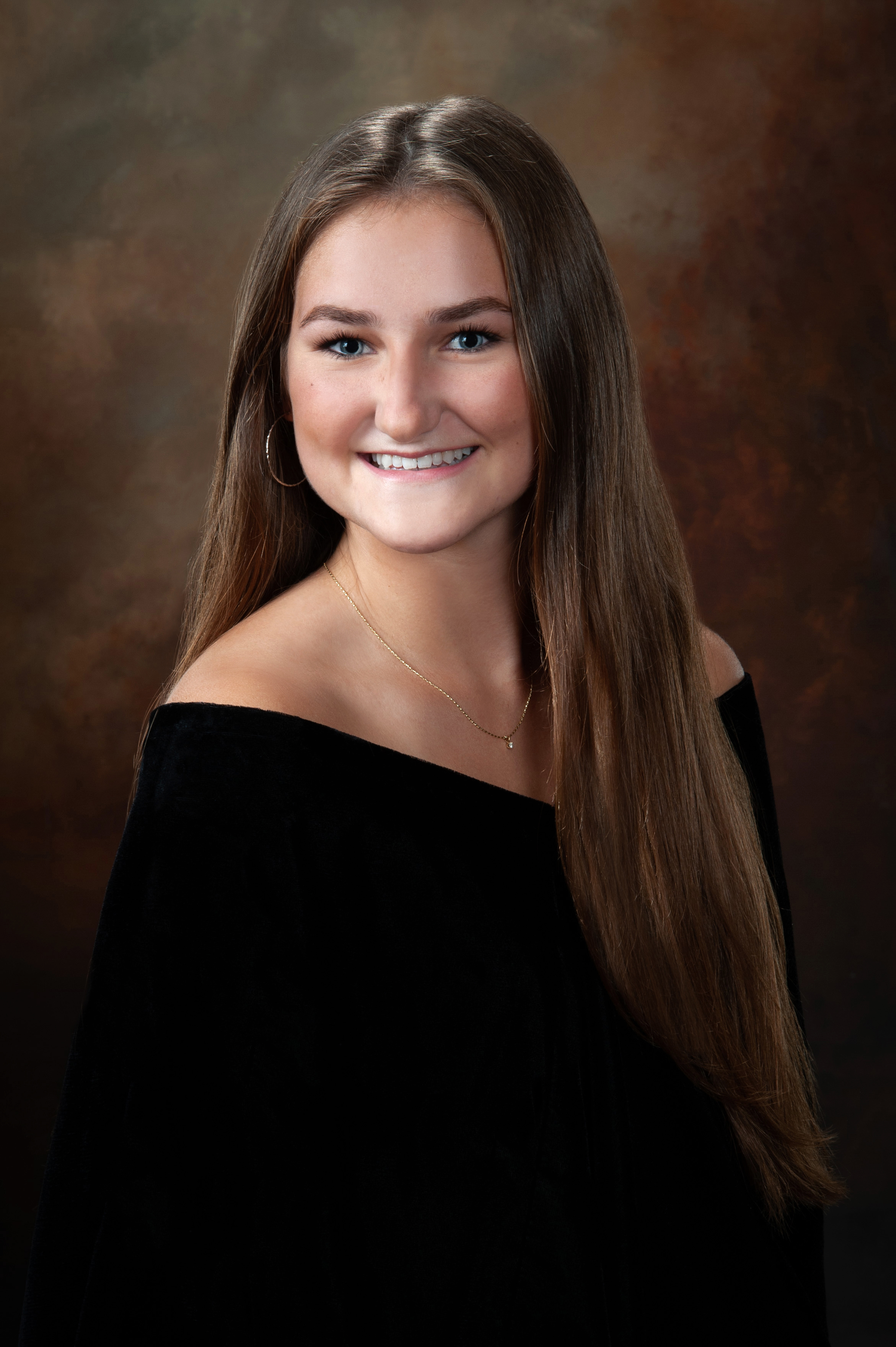
BIO
Kirsten is a second-year student majoring in Pre-Public Health and double minoring in Communications and Public Administration at Florida State University. She serves as an undergraduate research assistant for the recovery ally program and the campus rec program within the Center for Health Advocacy and Wellness. Specifically, through the recovery ally program, this program has not only taught her how to support her peers going through recovery but also understand how to reach out to those that may need support. Going forward, she plans on utilizing her voice to talk about the stigmas surrounding substance misuse and how to address misuse specifically on college campuses. Kirsten plans on attending graduate school for public health and being an ally and supporter of people in recovery and those that are wishing to be in recovery.
Using Challenge Course Education in Recovery Ally Programs
Authors: Kirsten Price, Chelsea ShoreStudent Major: Public Health
Mentor: Chelsea Shore
Mentor's Department: Higher Educational Leadership & Policy Studies Mentor's College: College of Education Co-Presenters: Mia Gomez
Abstract
The Recovery Ally Challenge Course was delivered to students in a fraternity at a large southeastern public 4-year institution. The program provided participants with an experiential learning activity with debrief questions that connected the process of recovery to physical activity in an effort to reduce the stigma surrounding addiction and recovery. The activity in this project focused on supporting students to develop skills needed for assessing their substance-using behaviors and forming recovery-friendly environments through critical self-reflection and problem-solving activities. This presentation will report on the implementation process, evaluation methods, and directions for scaling.
Keywords: Collegiate Recovery, Health and Wellness Initiatives, College student initiatives
23rd annual Undergraduate Research Symposium, April 6, 2023
Christian Porter Poster Session 4: 4:00 pm - 5:00 pm/ Poster #152
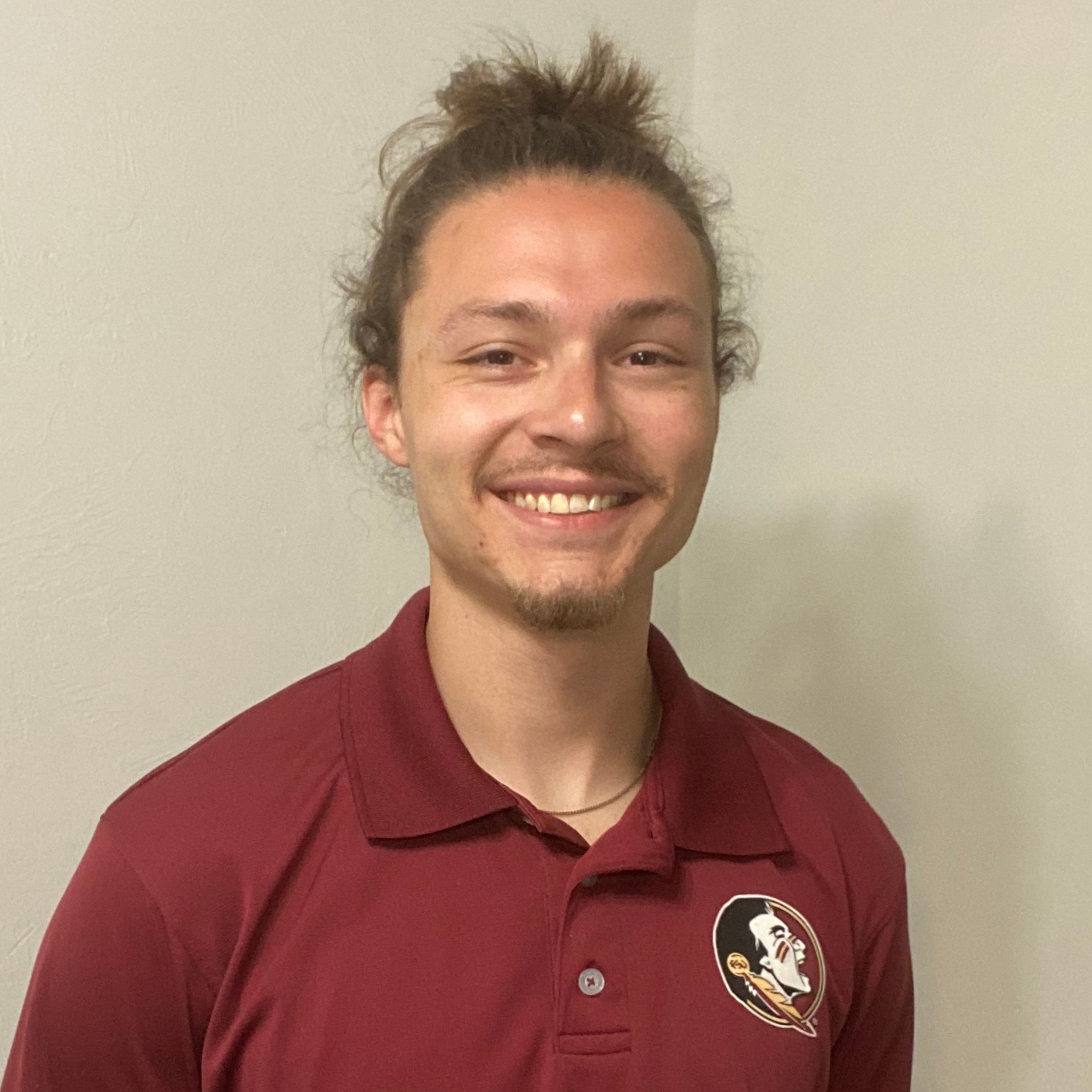
BIO
I am a recent graduate of the Behavioral Neuroscience program at FSU. I am currently in the process of gaining the necessary experience to apply for Ph.D. programs in the field of either neuroscience or clinical psychology. I am interested in conducting future research to better understand the physiological analogs of human behavior.
Pain-Induced Laughter: An Evolutionary Explanation and Proposed Mechanism
Authors: Christian Porter, David S. March, Ph.D.Student Major: Behavioral Neuroscience
Mentor: David S. March, Ph.D.
Mentor's Department: Psychology Mentor's College: Florida State University Co-Presenters: Maddie Stults, Sydney Byk, Valeria Huezo
Abstract
The present study explores a proposed mechanism for how the association between laughter and pain may have evolved. In highlighting this mechanism, we link research on the evolution of laughter with endogenous pain reduction to propose a model that argues that laughter became a conditioned response to pain.
Keywords: Social Psychology, Behavior, Communication, Evolution
24th annual Undergraduate Research Symposium, April 3, 2024
Mary Elizabeth Hotchkiss Poster Session 3: 1:30 pm - 2:30 pm /297

BIO
Hello! My name is Mary Elizabeth Hotchkiss, and I am a second-year student from Gulf Breeze, Florida majoring in Exercise Physiology. My research interests revolve around helping those less fortunate, which is part of what led me to join Dr. Dark’s research team. Once I complete my undergraduate studies, I am hoping to continue my education by attending Physician Assistant School.
The Impact of Depression on Cardiovascular Disease
Authors: Mary Elizabeth Hotchkiss, Dr. Tyra DarkStudent Major: Exercise Physiology
Mentor: Dr. Tyra Dark
Mentor's Department: Behavioral Sciences and Social Medicine Mentor's College: College of Medicine Co-Presenters: Juliana Perez-Soto
Abstract
Having depressive symptomology can greatly affect the management of cardiovascular diseases and increase the likelihood of adverse outcomes. The purpose of this research is to examine the relationship between depressive symptomology and its impact, if any, on participants with pre-existing cardiovascular disease. Data for this study comes from the 2017-March 2020 National Health and Nutrition Examination Survey (NHANES). Analyses were conducted to determine possible associations between the comorbidities. These results have the potential to positively inform health care for individuals who experience these comorbid conditions.
Keywords: depression, cardiovascular, community
24th annual Undergraduate Research Symposium, April 3, 2024
Liisi Schnippert Poster Session 2: 10:45 am - 11:45 am/86

BIO
I am a first year from Tallahassee, FL majoring in Behavioral Neuroscience pursuing minors in both Chemistry and Child Development. Following my undergraduate degree, I plan to attend medical school with a desire to become a pediatric psychiatrist. I decided to participate in this project as I am passionate about behavioral health and creating more accessible resources and treatments for individuals with behavioral health disorders and disabilities.
The Effect of Caffeine versus Placebo on Motor Performance in Parkinson’s Disease
Authors: Liisi Schnippert, Caroline MentonStudent Major: Behavioral Neuroscience
Mentor: Caroline Menton
Mentor's Department: Medicine Mentor's College: College of Medicine Co-Presenters:
Abstract
Parkinson’s disease (PD) is a neurodegenerative disease caused by the loss of dopaminergic neurons in the substantia nigra. The disease is characterized by a decline in motor quality such as speed of movements, slowness and stiffness of movement, postural instability, and increased risk of falling. Though there is currently no cure, the current standard of treatment for PD is symptom management with a medication called levodopa, which works by supplementing dopamine in the brain. This medication, while helpful, can have significant side effects and lose its efficacy over time. To improve the management of PD and maximize the potential of levodopa, researchers have been investigating additional therapies. Caffeine, which is known to have many neuroprotective effects, is one such therapy. Caffeine acts as an antagonist of the adenosine A2A receptor, which helps modulate the amount of dopamine in the substantia nigra. This modulatory effect may be used to improve motor performance at peak dose of levodopa therapy. The purpose of this study is to investigate the acute effects of caffeine on motor performance in PD. This is done through a series of tests, such as handwriting and the Purdue Pegboard test, before and after the ingestion of the pill containing caffeine or a placebo. The effects of such an inexpensive and accessible therapy have the potential to drastically improve the well-being of patients with PD.
Keywords: Parkinson's Disease, Motor Performance, Caffeine
24th annual Undergraduate Research Symposium, April 3, 2024
Sophia Morello Poster Session 3: 1:30 pm - 2:30 pm/36

BIO
I am a freshman here at Florida State University. I am a biology major with hopes of attending Physician Assistant (PA) school after graduation.
Assessing Social Validity of Educational Interventions for Children with Autism
Authors: Sophia Morello, Veronica FleuryStudent Major: Biological sciences
Mentor: Veronica Fleury
Mentor's Department: Special Education Mentor's College: School of Teacher Education Co-Presenters: Devon Mclean, Nihar Sanku, Madeline Mason
Abstract
Autism affects an estimated one in thirty-six children in the US. This highlights the importance of conducting research pertaining to effective instrumental practices with the intention of bringing an increased focus to this subject field. The project at hand conducts a scoping review of the social validity relevant to ASD intervention studies. As such, the research project will undergo four stages of a scoping review, including identification, screening, eligibility, and a quantitative synthesis. Many evidence-based instructional strategies have been proven helpful, but ultimately, these interventions are only useful if consumers are willing to use them and are socially valid. Consumers can include educators, caregivers, and the children themselves. The reason for social validity assessments is to anticipate if an intervention is going to be rejected before it is used. This study aims to determine what proportion of studies include social validity assessments, what methods researchers use to assess social validity, and whose perspectives are represented in the social validity assessments. The results of this research project are currently ongoing as we conduct the data extraction process.
Keywords: Social Validity, ASD, Autism



